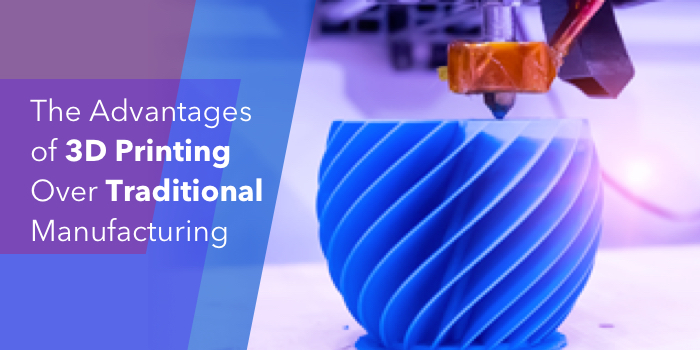Blogs The Advantages of 3D Printing Over Traditional Manufacturing
Blogs The Advantages of 3D Printing Over Traditional Manufacturing

3D printing creates parts with the help of objects built one layer at a time. Compared to the traditional methods of printing, this method of printing offers a lot of advantages. Although it is true that 3D printing is quite unlikely to replace some of the prevalent traditional printing methods, yet there are so many applications where this method of printing is used since it is able to deliver any design quickly and with high accuracy, from any functional material.
By understanding the advantages of 3D printing, designers can make better and informed decisions as they select a manufacturing process and choose to deliver an optimal end result.
Speed
One of the most important advantages of 3D printing is the speed at which parts can be produced as compared to the traditional modes of printing. You can upload complex designs from a CAD model and print them within a few hours. Rapid verification and quick development of design ideas are the advantages of this method. In the past, it would take days and even weeks to receive a prototype. Now, additive manufacturing delivers a model in the hands of the designer within a few hours. Though the technical and industrial 3D printing machines take a longer time to print and process any part, the ability to deliver functional end parts of mid volumes quickly offers a great time saving advantage to additive manufacturing when compared to traditional modes of manufacturing techniques.
Single step manufacturing
One of the biggest challenges for a designer is how he can manufacture a part as precisely and efficiently as possible. Most of the parts usually require a large number of manufacturing steps to be worked on by the traditional technologies. The order in which these steps generally occur affect the quality of the design and the end product. If we consider a custom steel bracket developed with the help of traditional manufacturing, it starts with a CAD model and once the design has been finalized, fabrication starts by first cutting the steel profiles into the perfect size. These profiles are thereafter clamped into position and welded one at a given time in order to form the bracket. Moreover, all the components will need to be aligned properly, only then will the welds be polished to perfection to give the best surface finish. After this, holes are drilled so that the bracket can be mounted at the top of the wall. At the end, the bracket gets sandblasted and painted to get the desired appearance. With 3D printing you can complete this build in a single step with not requiring any interaction with the machine operator during the time of the build phase. As soon as the CAD design gets finished, it can get uploaded in the machine and printed in a single step within a couple of hours. This ability of producing one part in one single step hugely reduces the dependence on several manufacturing processes and gives you greater control over the end result of final product.
Pricing
The costs of a manufacturing process can be broken down into three different categories: machine costs, material costs and labour costs.
Risk management
Ordering a defective prototype can cost you some good amount of time and money. Even minor changes in the fabrication or mould can create a bigger financial impact. By being able to verify any design with the help of a production ready prototype, you can eliminate the risks during the process of prototyping. This helps you to build confidence in your design before you make big investments required at the mass production level.
If you want to know more about 3D printing and its advantages, you can visit us at www.e-arc.in/printing-services/3D-printing/.
Fill up the details below
Fill up the details below
Fill up the details below